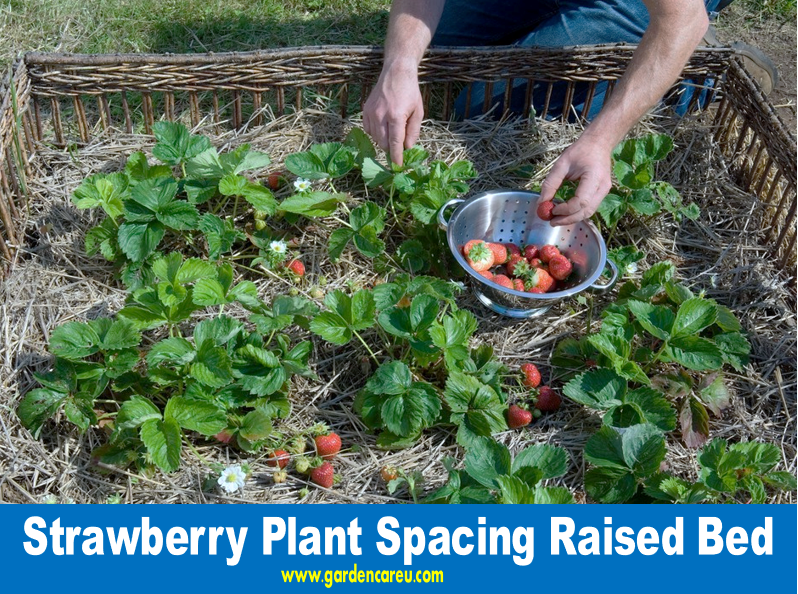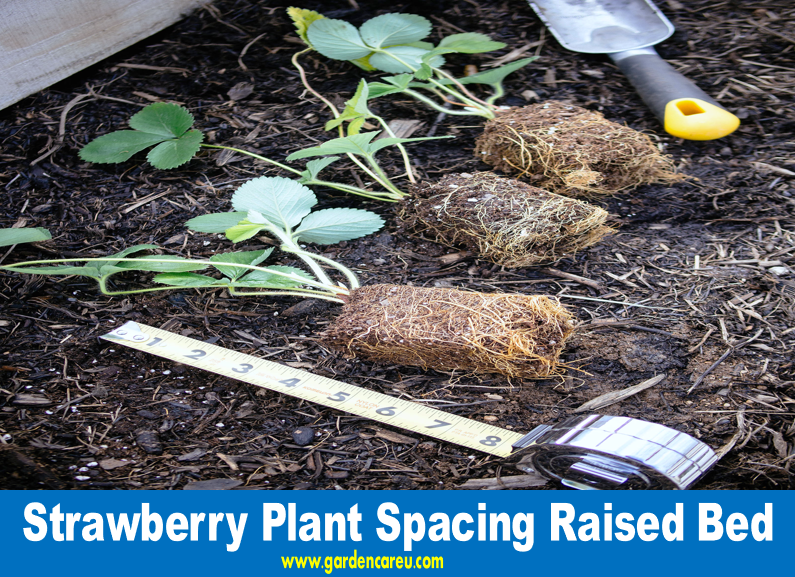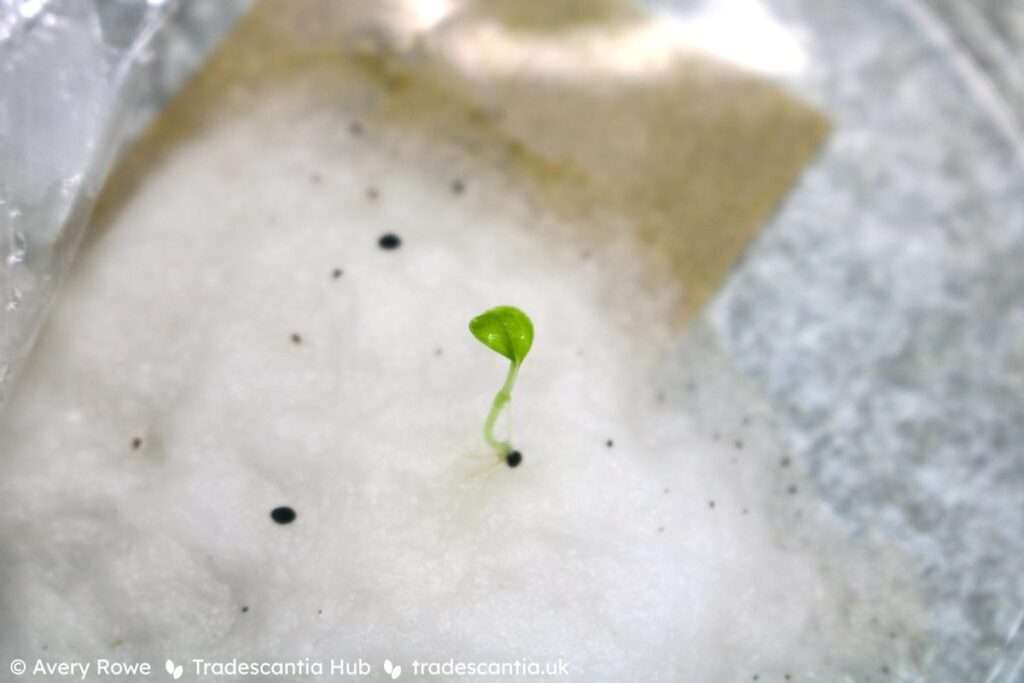Strawberry Plant Spacing Raised Bed: For optimal growth, space strawberry plants 12-18 inches apart in raised beds. Raised beds provide excellent drainage and soil aeration, promoting healthy strawberry growth.
Growing strawberries in raised beds allows for easy maintenance and protects against weeds. They prefer well-draining, slightly acidic soil enhanced with compost for nutrients. Raised beds offer fluffy soil, preventing waterlogged roots and allowing strawberries to thrive. Plant strawberries in raised beds for successful growth and a bountiful harvest.

Preparing The Raised Bed
Preparing the bed before planting strawberries in a raised bed is essential to creating an optimal growing environment for the plants. This involves choosing the right soil type, adjusting soil pH, and calculating fertilizer requirements.
Choosing The Right Soil Type
The right soil type is crucial for successfully growing strawberries in raised beds. Strawberries prefer well-draining, slightly acidic soil. Amend the soil with compost to enhance nutrient levels while ensuring good drainage to avoid waterlogged roots.
Adjusting Soil Ph
Adjusting the soil pH is important for creating an ideal strawberry-growing environment. Aim for a slightly acidic pH level, typically between 5.5 and 6.5. Soil testing kits are available to measure the pH level, and amendments can be made using materials such as sulfur or lime to achieve the desired pH range.
Calculating Fertilizer
Calculating the fertilizer requirements is essential to provide the nutrients for strawberry plants. Before planting, determining the appropriate amount of fertilizer based on the specific needs of the chosen strawberry varieties will ensure healthy plant growth and bountiful harvests.

Optimizing Planting Space
When planting strawberry plants in raised beds, adhering to proper spacing guidelines is essential to ensure maximum growth.
Properly spaced strawberry plants allow for adequate air circulation, sunlight exposure, and root development, leading to healthier and more productive plants.
Overcrowding can stunt the growth of strawberry plants, hinder their fruit production, and make them more susceptible to diseases.
To optimize planting space for strawberry plants in raised beds, follow these guidelines:
- Spacing Guidelines: Plant strawberry plants 12 to 18 inches apart in rows 2 to 3 feet apart.
- Benefits: Proper spacing allows for better airflow, sunlight penetration, and root development.
- Avoid Overcrowding: Crowded plants can lead to poor growth and increased disease risk.
| Plant | Spacing (inches) |
|---|---|
| Strawberry Plants | 12-18 |
| Rows | 2-3 feet apart |
Ensure each strawberry plant has enough space to thrive and reach its full potential, resulting in a bountiful harvest of delicious strawberries.
Caring For Strawberry Plants
Proper spacing is crucial when planting strawberries in a raised bed. Aim for about 12-18 inches between plants to ensure they have enough room to grow and spread. This allows for good air circulation and helps prevent diseases. Proper spacing also facilitates easier harvesting and maintenance of the plants.
Root Trimming Guidelines
When caring for your strawberry plants in a raised bed, paying attention to their root growth is essential. To ensure healthy and productive plants, it is recommended to trim the roots before planting. This process promotes better nutrient absorption and prevents overcrowding of roots. Here are some guidelines to follow when trimming the roots of your strawberry plants:
- Start by carefully removing the plant from its container or the ground, careful not to damage the roots.
- Gently shake off any excess soil to get a clear view of the roots.
- Inspect the roots for any signs of damage or disease. If you notice any rotten or blackened roots, remove them using sterilized pruning shears.
- Trim the remaining roots, cutting about a third of their length. This encourages the growth of new, healthy roots. Make clean cuts to avoid causing unnecessary stress to the plant.
- After trimming, soak the roots in a bucket of water for about 20-30 minutes to hydrate them before planting.
Remember, root trimming should be done cautiously, as excessive trimming can hinder plant growth. Striking the right balance between removing damaged roots and preserving healthy ones is crucial for the plant’s overall health.
Planting Depth Recommendations
Knowing the proper planting depth for your strawberry plants is vital for their successful growth and development. Here are some recommendations to keep in mind when planting your strawberries in a raised bed:
- Dig a hole deep enough to accommodate the plant’s root system comfortably.
- Place the strawberry plant in the hole, ensuring that the crown sits at ground level. The crown is the area where the stem meets the roots.
- If you plant bare-root strawberries, spread the roots out in the hole, allowing them to extend naturally.
- For potted or container-grown strawberries, gently loosen the root ball before planting, ensuring the roots are not tightly bound.
- Carefully backfill the hole with soil, ensuring the roots are completely covered and no air pockets.
- Press the soil gently around the roots to provide stability and ensure good contact.
Planting your strawberries at the appropriate depth gives them the best chance to establish themselves and thrive in the raised bed environment.
Importance Of Labeling
Proper labeling is often overlooked when caring for strawberry plants, but it plays a crucial role in keeping track of different varieties and their specific needs. Here is why labeling your strawberries is essential:
- Identification: Labeling allows you to distinguish between different strawberry varieties. This is especially important if growing multiple varieties in the same raised bed.
- Monitoring Growth and Performance: By labeling your plants, you can easily track their growth and evaluate which varieties perform best in your specific growing conditions.
- Harvesting: Knowing which plants are at what ripeness stage helps you harvest at the right time, ensuring maximum flavor and sweetness.
- Troubleshooting: If any issues arise during the growing season, labeling helps you identify and address them more effectively by pinpointing specific plants and their characteristics.
Labeling your strawberry plants can be as simple as using waterproof markers on wooden labels or utilizing specialized plant markers available in the market. Whichever method you choose, the important thing is to maintain clear and legible labels throughout the growing season.
Maximizing Yield
Maximizing yield is essential when growing strawberries in a raised bed. The correct spacing, pruning, and watering techniques can significantly impact the quantity and quality of your harvest. Implementing these practices will ensure your strawberry plants thrive and produce delicious berries. Let’s explore some helpful tips for maximizing strawberry yield in a raised bed.
Tips For Pruning And Trimming
Proper pruning and trimming play a crucial role in maximizing strawberry yield. Regularly trim old or damaged leaves to promote new growth and reduce disease risk. Removing excess runners will direct the plant’s energy into fruit production, resulting in a larger and healthier harvest.
Watering And Mulching Techniques
Consistent watering is essential for healthy strawberry plants. Apply water at the base of the plants to avoid wetting the foliage, which can lead to disease. Mulching around your strawberries will help retain moisture, suppress weeds, and maintain a steady soil temperature, ultimately contributing to increased fruit production. Consider using organic materials such as straw or wood chips for optimal results.
Frequently Asked Questions For Strawberry Plant Spacing Raised Bed
How Many Strawberries Can I Grow In A 4×8 Raised Bed?
In a 4×8 raised bed, you can grow approximately 24 to 32 strawberry plants.
How Far Apart Do You Plant Strawberries In A Raised?
Strawberries should be planted in a raised bed about 12 to 18 inches apart. This allows enough room for the plants to spread and receive adequate sunlight and air circulation.
Do Strawberries Do Well In Raised Beds?
Strawberries thrive in raised beds with well-draining, slightly acidic soil. Amend the soil with compost for nutrients and ensure good drainage. Raised beds promote fluffy soil, prevent weeds and grass invasion, and are ideal for growing strawberries.
Can Strawberry Plants Be Too Close Together?
Strawberry plants can be too close together. Proper spacing ensures healthier growth and better yields.
What Is The Ideal Soil Type For Growing Strawberries In Raised Beds?
The ideal soil for growing strawberries in raised beds is well-draining and slightly acidic. It is recommended to amend the soil with compost for added nutrients and ensure good drainage to prevent soggy roots.
Why Are Raised Beds Ideal For Growing Strawberries?
Raised beds are ideal for growing strawberries because they promote fluffy and well-drained soil. They also help prevent invasion from weeds and grass, providing a suitable environment for the growth of strawberries.
Conclusion
Mastering the proper strawberry plant spacing in a raised bed can significantly impact the growth and yield of your strawberries. Following the guidelines will ensure your plants have enough room to thrive and produce abundant, sweet berries. With well-spaced strawberries, you can create a healthy and productive garden bed.


